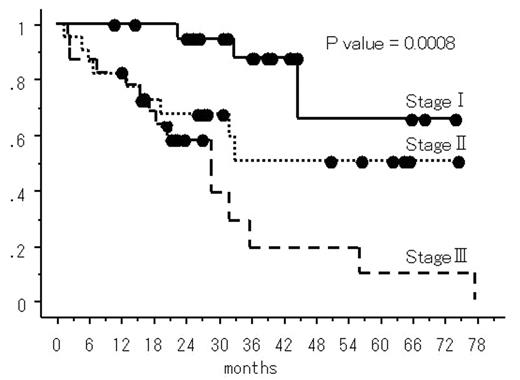Abstract
Introduction: Since multiple myeloma (MM) is not a curative disease and clinical outcome is variable, chemotherapy is started only when patients developed organ impairment or progression of disease. As for clinical staging, Durie&Salmon (DS) system is in use. The International Staging System (ISS) for MM has been recently reported to provide simple and useful prognostic grouping (Greipp et al. 2005). However, its usefulness in therapeutic strategy has not been clearly demonstrated.
Patients and methods: We reviewed medical records of patients with MM, newly diagnosed in Toyohashi Municipal Hospital between May 1997 and April 2004. They were all stratified based on both ISS and DS system.
Results: The median age of 55 patients was 67 years (range; 46–86). M protein isotypes included IgG (n=33), IgA (n=13), BJP (n=6) and IgD (n=1). Fifty-two patients were treated with chemotherapy and 12 of those patients underwent autologous peripheral blood stem cell transplantation. The median follow-up of the patients was 26.8 months (range; 1.4–77.5). Their staging and overall survival (OS) are summarized on the following table. ISS predicted OS more clearly than DS system in our study.
Overall survival based on ISS and DS system
| . | ISS . | . | DS . | . |
|---|---|---|---|---|
| stage . | no. of patients . | OS at 3 yrs . | no. of patients . | OS at 3 yrs . |
| I | 14 | 1.00 | 3 | 0.67 |
| II | 22 | 0.55 | 20 | 0.79 |
| III | 19 | 0.25 | 32 | 0.40 |
| p-value | 0.0102 | 0.3287 |
| . | ISS . | . | DS . | . |
|---|---|---|---|---|
| stage . | no. of patients . | OS at 3 yrs . | no. of patients . | OS at 3 yrs . |
| I | 14 | 1.00 | 3 | 0.67 |
| II | 22 | 0.55 | 20 | 0.79 |
| III | 19 | 0.25 | 32 | 0.40 |
| p-value | 0.0102 | 0.3287 |
Thirteen of the 14 patients with ISS stage I are alive at median months of 31.5 (10.4–73.8), and only one patient died of secondary malignancy at 44.9 months from diagnosis. The patients with ISS stage I included 86% of DS stage II and III patients, who are usually required treatment.
Conclusions and discussions: ISS could predict clinical outcome more clearly than DS system. The patients’ prognosis was good in ISS stage I although many patients with DS stage II and III was included in this group. We suggests that early treatment to the patients with ISS stage I might not be necessarily required. Further studies are needed to adopt ISS instead of DS system in therapeutic strategy.
Author notes
Corresponding author


